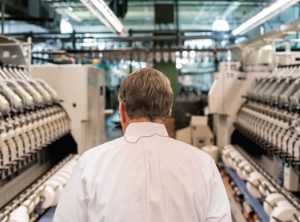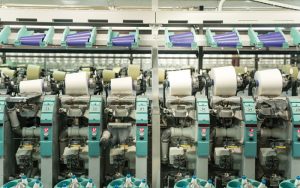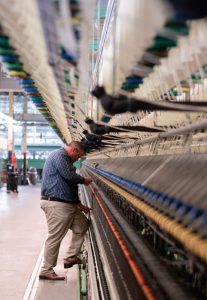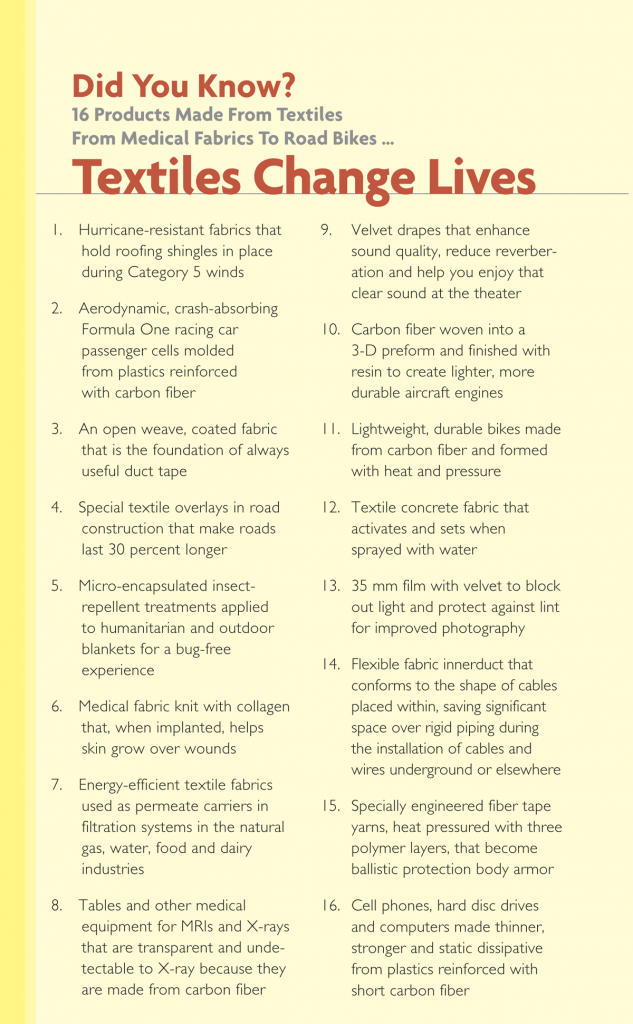Before a single pound of yarn can be spun or a yard of fabric can be woven, a capital investment must be made to secure the means of production. In a positive sign, capital investments by America’s textile industry have surged during recent years, driven by growing demand for innovative textile products, expanding exports and greater recognition of the added value of domestic sourcing. In the most recent government statistics, annual capital investments by U.S. textile mills reached nearly $1.7 billion in 2015, a 75 percent increase from $960 million in 2009.
National Spinning Co. Inc. — a Washington, N.C.-based, employee-owned company founded in 1921 — is one such example of how demand for technically advanced textiles is driving capital expenditures in America’s textile industry. Nonwovens are textiles made from long fibers, bonded together by chemical, mechanical, heat or solvent treatment instead of being woven or knitted together. In 2012, National Spinning identified this market as a growth opportunity to complement its long-held leadership in specialty yarns.
To execute its strategy, National Spinning acquired a nonwoven fabric manufacturer in Lincolnton, N.C. Soon, the company was supplying a wide range of innovative fabrics for the automotive, home appliance, construction, noise abatement, insulation and bedding markets from its Carolina Nonwovens division. Its entry into the nonwovens business was so successful that National Spinning had to quickly consider expansion options.
“We weren’t able to expand at the existing location, and we couldn’t find a suitable existing building within a 20-mile radius, which was essential because we were committed to keeping our existing employees onboard with the expansion,” said Jim Booterbaugh, president of National Spinning. “That’s when we decided to go ‘greenfield’ and build a new plant on an 11-acre site nearby in Maiden, N.C.” By designing a new manufacturing center from the ground up, National Spinning built a facility tailored to its nonwovens business. The new facility emphasized a simplified workflow, enhanced flexibility, improved quality, increased efficiency, space for ancillary services and a positive work environment. Grand opening festivities for the $12 million, 92,000-square-foot manufacturing center — projected to create 65 new jobs — were held in July 2016.
 Technology A Major Factor In Capital Investments
Technology A Major Factor In Capital Investments
Continual innovations in textile equipment and processes also are driving capital investments by U.S. textile companies as illustrated by a recent expansion by Wichita, Kan.-based INVISTA, an international leader in the production of nylon, spandex, polyester and specialty materials.
In August 2016, Invista announced a $30 million expansion of its fiber manufacturing plant in Camden, S.C. This investment represented the industry’s first one-step, small-lot capability specifically for solution-dyed nylon 6,6 — a form of nylon with superior resilience and stain resistance for carpet.
“Our mill customers and the design community rely on Invista to offer a palette of hundreds of solution-dyed nylon 6,6 colors for each of their unique design preferences,” said Marc Ahrens, vice president of Invista’s specialty flooring business. “The new technology is expanding our capability to offer sophisticated color families while improving service.”
Invista developed its new, proprietary small-lot technology by working closely with Germany-based equipment supplier Trützschler GmbH & Co. KG, which supports manufacturing and customer service sites all around the world. The variety of small-lot nylon 6,6 fibers are initially being offered under Invista’s Antron® Lumena™ brand to serve expanding global markets.
 Perceptions Shifting Toward Domestic Sourcing
Perceptions Shifting Toward Domestic Sourcing
Yet another factor favoring capital investments by the U.S. textile industry is a growing recognition that sourcing offshore is not always as profitable as sourcing regionally or even locally for brands and retailers. While conventional wisdom has long held that clothing and home furnishings must be sourced from Asia to be price-competitive, recent research illustrates that certain initial cost advantages can quickly disappear due to the inherent disadvantages of sourcing overseas.
“Sourcing products from Asia requires long lead times, which can result in a mismatch of production and consumer demand,” said David Sasso, vice president of sales for Buhler Quality Yarns, Jefferson, Ga., a producer of luxury-branded yarns made using Supima cotton. “When a brand orders so far ahead of the market, it can easily order too much product, which results in heavy discounting, or it can order too little, which means it won’t meet demand. The goal of our industry is to help brands document the real costs of sourcing abroad.”
To create greater efficiency and speed-to-market in the apparel supply chain, Buhler Quality Yarns is one of many advocates for an interactive cost-calculating tool innovated by MIT’s Sloan School of Management. By working with the National Cotton Council and others who specialize in supply chain processes and technologies, Buhler is using the tool to deepen the apparel industry’s understanding of how to more accurately value the time and risk involved with offshoring.
“This new tool enables brands to analyze the variables that can turn an initial price advantage from Asia into money left on the table because of having to order several weeks ahead of the market,” Sasso said. “We also emphasize to our customers the risks involved in international shipping and the potential loss of intellectual property when working with non-domestic sources.”
For Sasso, one of the strongest arguments for domestic sourcing is the opportunity for brands and various elements of the textile supply chain to collaborate in creating value-added products that will inspire consumers to buy.
“When the supply chain starts thinking like a consumer, we can come up with so many ideas that can help designers create better products that improve margins for everyone,” he said. “We know that by sourcing domestically, this type of collaboration is far easier and far more effective.”
Editor’s Note: This article appears in Textile World courtesy of the National Council of Textile Organizations (NCTO) as part of the “American Textiles: We Make Amazing™” campaign. NCTO is a trade association representing U.S. textile manufacturing. Please visit ncto.org to learn more about NCTO, the industry and the campaign.
July/August 2017






